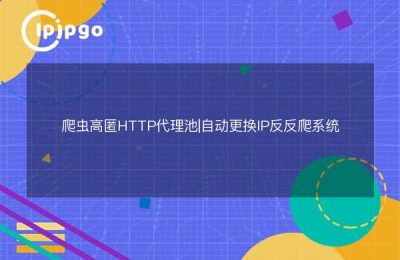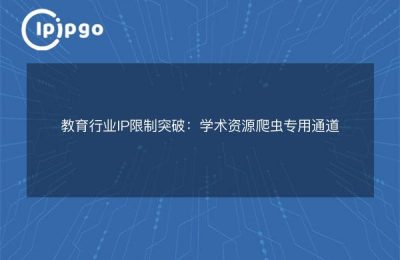
In the world of data crawling, the proxy IP is like a crawler's invisibility cloak, helping us to travel freely on the network and avoid being recognized and blocked by the target website. Today I'm going to share tips on crawler proxy pool deployment and high concurrency implementation, I hope it will help you.
What is a Crawler Agent Pool?
First of all, we have to figure out what is the crawler proxy pool. Simply put, the proxy pool is a storage proxy IP "pool", the crawler can work from this pool to take out the proxy IP, replace their real IP, so as to avoid being banned by the target site. The good or bad proxy pool directly affects the efficiency and stability of the crawler.
Deployment of Crawler Agent Pool
The deployment of an agent pool is not really complicated and is divided into the following steps:
1. Obtain a proxy IP
The most basic step is to get a proxy IP, there are many free and paid proxy IP service providers in the market. The quality of free proxy IPs varies and there may be a lot of unavailable IPs, while paid proxy IPs are relatively stable. There are many ways to get a proxy IP, you can get it through the API interface, or you can crawl it from some websites.
import requests
def get_proxies(): url = ''
url = 'https://api.proxyscrape.com/?request=displayproxies&proxytype=http'
response = requests.get(url)
proxies = response.text.split('n')
return proxies
2. Verify proxy IP
After obtaining the proxy IPs, we need to verify these IPs. The purpose of validation is to ensure that these IPs are available. The availability and response speed of the IPs can be verified by sending an HTTP request. Generally speaking, IPs with fast and stable response time are more suitable as proxy IPs.
def validate_proxy(proxy):
url = 'http://httpbin.org/ip'
try.
response = requests.get(url, proxies={'http': proxy, 'https': proxy}, timeout=5)
if response.status_code == 200:: response.status_code == 200: response.status_code == 200
return True
return True: if response.status_code == 200: return True
return False
return False
proxies = get_proxies()
valid_proxies = [proxy for proxy in proxies if validate_proxy(proxy)]3. Storage proxy IP
The verified proxy IPs need to be stored for the crawler to call at any time. The proxy IP can be stored in a database, such as Redis or MongoDB, which supports highly concurrent access and can meet the needs of the crawler.
import redis
def store_proxies(proxies):
r = redis.Redis(host='localhost', port=6379, db=0)
for proxy in proxies: r.sadd('proxies')
r.sadd('proxies', proxy)
store_proxies(valid_proxies)High Concurrency Implementation Methods
High concurrency is an important feature of the crawler agent pool, which can improve the efficiency of the crawler. There are many ways to achieve high concurrency , the following is a description of several commonly used methods .
1. Multi-threading
Multi-threading is a basic method to achieve high concurrency. By enabling multiple threads, a crawler can send multiple requests at the same time, thus increasing the crawling speed.The `threading` library in Python makes it easy to implement multithreading.
import threading
def fetch_url(url, proxy):
try.
response = requests.get(url, proxies={'http': proxy, 'https': proxy})
print(response.text)
print(response.text)
pass
url = 'http://example.com'
threads = []
for proxy in valid_proxies: threading.Thread(target=fetch_url, args=(url, proxy))
t = threading.Thread(target=fetch_url, args=(url, proxy))
threads.append(t)
t.start()
for t in threads.
t.join()2. Asynchronous IO
In addition to multi-threading, asynchronous IO is also an effective way to achieve high concurrency. Asynchronous IO realizes non-blocking IO operations through the event loop mechanism, which can significantly improve the concurrency performance of the crawler.The `asyncio` library in Python is specially designed to implement asynchronous IO.
import aiohttp
import asyncio
async def fetch_url(session, url, proxy)::
try: async with session.get(url, proxy=f'{proxy}')
async with session.get(url, proxy=f'http://{proxy}') as response.
print(await response.text())
except: async with session.get(url, proxy=f'{proxy}')
async with session.get(url, proxy=f'{proxy}')
async def main(): url = ''
url = 'http://example.com'
async with aiohttp.ClientSession() as session.
tasks = [fetch_url(session, url, proxy) for proxy in valid_proxies]
await asyncio.gather(*tasks)
asyncio.run(main())3. Distributed crawlers
When the performance of a single machine reaches a bottleneck, consider using a distributed crawler. Distributed crawlers can dramatically improve crawling efficiency by distributing tasks to multiple machines for execution. Commonly used distributed crawler frameworks are Scrapy-Redis and PySpider.
# Scrapy-Redis example configuration
# settings.py
SCHEDULER = "scrapy_redis.scheduler.Scheduler"
DUPEFILTER_CLASS = "scrapy_redis.dupefilter.RFPDupeFilter"
REDIS_URL = 'redis://localhost:6379'
# Using Redis to store proxy IPs in the crawler code
import redis
from scrapy_redis.spiders import RedisSpider
class MySpider(RedisSpider).
name = 'my_spider'
redis_key = 'my_spider:start_urls'
def __init__(self, *args, **kwargs): super(MySpider, self).
super(MySpider, self). __init__(*args, **kwargs)
self.redis = redis.Redis(host='localhost', port=6379, db=0)
def make_requests_from_url(self, url):
proxy = self.redis.srandmember('proxies').decode('utf-8')
return scrapy.Request(url, meta={'proxy': f'http://{proxy}'})Agent pool maintenance
Once the agent pool is deployed, regular maintenance is required. Proxy IPs can fail over time and need to be updated and verified on a regular basis. A timed task can be set up to periodically check the availability of proxy IPs and remove failed IPs from the proxy pool.
1. Proxy IP update
In order to keep the proxy pool alive, new proxy IPs need to be obtained from the proxy provider and added to the proxy pool on a regular basis. This ensures that there are always enough available IPs in the proxy pool.
2. Proxy IP verification
Proxy IP verification is an ongoing process. You can set a timed task to validate the IPs in the proxy pool at regular intervals and eliminate the invalid IPs. this ensures the quality of the proxy pool.
import time
while True: proxies = get_proxies()
proxies = get_proxies()
valid_proxies = [proxy for proxy in proxies if validate_proxy(proxy)]
store_proxies(valid_proxies)
time.sleep(3600) # Update every hoursummarize
Crawler agent pool deployment and high concurrency implementation is an important part of data crawling. By reasonably deploying the agent pool and realizing high concurrency, you can significantly improve the efficiency and stability of the crawler. I hope this article can help you, I wish you in the road of data crawling farther and farther!








